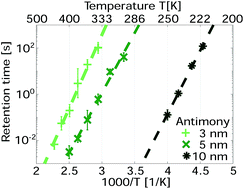当前位置:
X-MOL 学术
›
Faraday Discuss.
›
论文详情
Our official English website, www.x-mol.net, welcomes your
feedback! (Note: you will need to create a separate account there.)
Exploiting nanoscale effects in phase change memories
Faraday Discussions ( IF 3.3 ) Pub Date : 2018-11-07 , DOI: 10.1039/c8fd00119g Benedikt Kersting 1, 2, 3, 4, 5 , Martin Salinga 1, 2, 3, 4, 5
Faraday Discussions ( IF 3.3 ) Pub Date : 2018-11-07 , DOI: 10.1039/c8fd00119g Benedikt Kersting 1, 2, 3, 4, 5 , Martin Salinga 1, 2, 3, 4, 5
Affiliation

|
The market launch of Intel’s 3D XPoint™ proves phase change technology has grown mature. Besides storing information in a fast and non-volatile way, phase change memories (PCMs) may facilitate neuromorphic and in-memory computing. In order to establish PCM as a lasting element of the electronics ecosystem, scalability to future technology nodes needs to be assured. Continued miniaturization of PCM devices is not only prescribed in order to achieve memories with higher data density and neuromorphic hardware capable of processing larger amounts of information. Smaller PCM elements are also incentivized by the prospect of increased power efficiency per operation as less material needs to be heated up for switching. For this reason, a good understanding of the effects of confinement on phase change materials is crucial. Here we describe how miniaturization increases the importance of interface effects and we show how in consequence the crystallization kinetics of phase change materials, when confined into nanometer sized structures, can change significantly. Based on this analysis, the implications of such nanoscale effects are discussed and possible ways of exploiting them proposed.
中文翻译:

利用相变存储器中的纳米级效应
英特尔3D XPoint™的市场投放证明相变技术已经成熟。除了以快速且非易失性的方式存储信息外,相变存储器(PCM)还可促进神经形态和内存计算。为了将PCM建立为电子生态系统的持久元素,需要确保对未来技术节点的可扩展性。不仅要求PCM设备继续小型化,以实现具有更高数据密度的存储器和能够处理大量信息的神经形态硬件。每次操作提高功率效率的前景也激励了更小的PCM元件,因为切换所需的材料较少,因此需要加热的材料更少。因此,对限制对相变材料的影响的良好理解至关重要。在这里,我们描述了微型化如何增加界面效应的重要性,并说明了相变材料的结晶动力学在局限在纳米级结构中时将如何发生显着变化。基于此分析,讨论了这种纳米尺度效应的含义,并提出了利用它们的可能方法。
更新日期:2019-02-19
中文翻译:

利用相变存储器中的纳米级效应
英特尔3D XPoint™的市场投放证明相变技术已经成熟。除了以快速且非易失性的方式存储信息外,相变存储器(PCM)还可促进神经形态和内存计算。为了将PCM建立为电子生态系统的持久元素,需要确保对未来技术节点的可扩展性。不仅要求PCM设备继续小型化,以实现具有更高数据密度的存储器和能够处理大量信息的神经形态硬件。每次操作提高功率效率的前景也激励了更小的PCM元件,因为切换所需的材料较少,因此需要加热的材料更少。因此,对限制对相变材料的影响的良好理解至关重要。在这里,我们描述了微型化如何增加界面效应的重要性,并说明了相变材料的结晶动力学在局限在纳米级结构中时将如何发生显着变化。基于此分析,讨论了这种纳米尺度效应的含义,并提出了利用它们的可能方法。











































 京公网安备 11010802027423号
京公网安备 11010802027423号